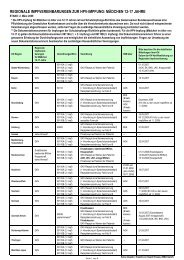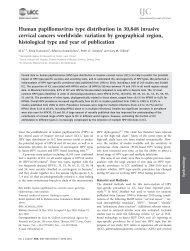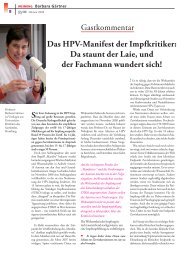You also want an ePaper? Increase the reach of your titles
YUMPU automatically turns print PDFs into web optimized ePapers that Google loves.
3: <strong>HPV</strong> AND CERVICAL CANCER: PUBLIC HEALTH PERSPECTIVES12. Snijders PJ, van den Brule AJ, Meijer CJ. The clinical relevance of humanpapillomavirus testing: relationship between analytical and clinicalsensitivity. J Pathol 2003;201:1–613. Josefsson AM, Magnusson PK, Ylitalo N et al. Viral load of humanpapilloma virus 16 as a determinant for development of cervical carcinomain situ: a nested case-control study. Lancet 2000;355:2189–9314. Lorincz AT, Richart RM. Human papillomavirus DNA testing as an adjunctto cytology in cervical screening programs. Arch Pathol Lab Med2003;127:959–6815. Zielinski GD, Snijders PJ, Rozendaal L et al. <strong>HPV</strong> presence precedesabnormal cytology in women developing cervical cancer and signals falsenegative smears. Br J Cancer 2001;85:398–40416. Jain S, Tseng CJ, Horng SG et al. Negative predictive value of humanpapillomavirus test following conization of the cervix uteri. Gynecol Oncol2001;82:177–8017. Kucera E, Sliutz G, Czerwenka K et al. Is high-risk human papillomavirusinfection associated with cervical intraepithelial neoplasia eliminated afterconization by large-loop excision of the transformation zone? Eur J Obstet,Gynecol Reprod Biol 2001;100:72–0618. Lin CT, Tseng CJ, Lai CH et al. Value of human papillomavirusdeoxyribonucleic acid testing after conization in the prediction of residualdisease in the subsequent hysterectomy specimen. Am J Obstet Gynecol2001;184:940–519. Kanamori Y, Kigawa J, Minagawa Y et al. Residual disease and presence ofhuman papillomavirus after conization. Oncology 1998;55:517–2020. Nobbenhuis MA, Meijer CJ, van den Brule AJ et al. Addition of high-risk<strong>HPV</strong> testing improves the current guidelines on follow-up after treatment forcervical intraepithelial neoplasia. Br J Cancer 2001;84:796–80121. Zielinski GD, Snijders PJ, Rozendaal L et al. The presence of high-risk <strong>HPV</strong>combined with specific p53 and p16INK4a expression patterns points tohigh-risk <strong>HPV</strong> as the main causative agent for adenocarcinoma in situ andadenocarcinoma of the cervix. J Pathol 2003;201:535–4334








